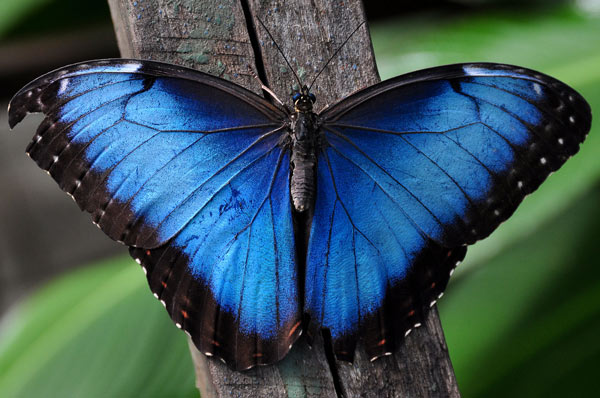
Description: The stunning Blue Morpho Butterfly is one of 80 species classified as Morpho butterflies. The Blue Morpho Butterfly is a large butterfly with a wingspan that may measure up to six inches. It has iridescent blue wings with black wing edges. The upper edges are flecked with white. The butterfly's brilliant blue coloration is the result of light diffraction from millions of tiny scales on the wings. Females are much less colorful than males. The underside of the Blue Morpho Butterfly is pale in coloration with large false eyespots. Today, the wings of the Blue Morpho Butterfly are often used in native ceremonies, jewelry, and woodworking. Significant numbers of these insects are displayed in butterfly gardens throughout the world.
Range: Morpho butterflies are found in the rainforests of Mexico, Central America, and South America. Adults spend most of their time on the forest floor and on lower shrubs and branches of the understory. Blue Morpho Butterflies may sometimes be found in open fields and meadows sunning themselves, where they are most likely to be observed by humans.
Life Cycle: The life cycle of the Blue Morpho Butterfly lasts for about 115 days from egg to butterfly. The female lays a cluster of tiny, green eggs that hatch in about nine days. The eggs are attached on the underside of a leaf with special "glue" secreted by the butterfly. Upon hatching, the caterpillars begin eating. Some reports have suggested the caterpillars will eat other caterpillars. The caterpillars are brown with large green spots. They have prickly hairs that irritate birds that try to eat them. The caterpillar will progress through four to six instars (periods of time between molting) before forming its jade-green chrysalis and beginning metamorphosis. Inside the chrysalis, the caterpillar will actually become liquid that reorganizes into a butterfly. The chrysalis emits a repulsive, ultrasonic sound when touched by predators.
When the adult butterfly emerges, it only has a life cycle of two or three weeks to feed and mate. Butterflies feed on fermenting fruit. The fermenting fruit contains traces of alcohol that actually cause the butterfly inebriation (drunkenness). This makes them easy to catch.
|